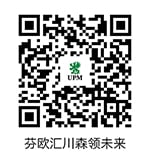Innovative utilisation of side streams plays an important role in circular bioeconomy. Many of our products are made of residues, side streams and waste generated during traditional production processes.
Circular bioeconomy in action
Five secrets of success: Replacing fossil-based plastics in the LUMENE moisturiser jar
Closing the loop with renewable plastics
Renewable bio-based plastics offer all the convenience of conventional plastics, but with a greatly reduced carbon footprint.
Arla to bring 40 million wood-based packages into supermarkets
Arla wants to provide consumers with new opportunities to choose more responsible products. Arla was the first company in Finland to use renewable wood-based bioplastics in gable top paperboard cartons for milk, yoghurt and cooking products.The tall oil-based raw material is a Finnish innovation by UPM.
UPM Raflatac collects label waste from its customers and partners
This waste is recycled using a variety of RafCycle® recycling solutions.
UPM LinerLoop™ release liner recycling
A unique circular solution for recycling the used release liners.
Paper recycling is a good example of the circular economy in action
UPM is one of the biggest users of recovered paper in the graphic paper industry. We used 0.7 million tonnes of recovered paper in 2024. Recycled fibre represents 15% of all the fibre used in our paper production.
Recovered paper is an essential raw material for us. We want to safeguard its availability by co-operating with communities and wastepaper companies. Most paper can be recycled. This includes used newspapers, cardboard, packaging, stationery, direct mail, magazines, catalogues, greeting cards, envelopes and wrapping paper.
Recycling is the most sustainable way to give paper a new life.
Lignin, a by-product of pulp production, is used in WISA BioBond gluing technology, which is used in plywood manufacturing
Ash from biomass-based energy generation is used in several product applications
Ash can be used in soil stabilisation or in the cement industry, or internally for replacing caustic soda or PCC. In 2024, 83% of our ash was reused.
A good example of our out-of-the-box thinking is our fly ash innovation, Elurit, which can be used during the bleaching stage of the papermaking process to replace caustic soda. Another is Cinerit, a fly ash-based soil stabilisation product. The UPM Schongau paper mill and SMI have together developed a new process for producing precipitated calcium carbonate (PCC) from ash.
A breakthrough in recycling ash
The UPM Schongau paper mill in Germany and on-site partner SMI developed together a new process for producing precipitated calcium carbonate (PCC) from residue ash. The new process is a breakthrough in many ways: it is a new smart way to use residue ash and saves a great amount of energy in the bargain.
We aim to use only recycled nutrients at our effluent treatment plants by 2030
Our latest commitment to Baltic Sea Action Group diverts ship-generated wastewater discharge from sea to land
In June 2022 we published our latest commitment to the Baltic Sea Action Group (BSAG) for the years 2022 - 2026. Along the commitment we became the first Finnish company, acting as a shipper and charterer, to discharge our ship-generated wastewater on land and to utilise various circular economy solutions in wastewater treatment. The commitment focuses on promoting BSAG's Ship Waste Action initiative. The initiative aims to establish a model whereby cargo ship effluents are discharged at the port, and their nutrients are recycled through circular economy solutions.
Read the press release
A delicious meal cooking in the composting plant of Kekkilä for the micro-organisms of UPM Kaukas water treatment plant
From the beginning of 2019 approximately one third of the nutrients used by UPM Kaukas mill integrate’s biological wastewater treatment plant has been replaced by Kekkilä Recycling Joutseno composting plant’s side stream: reject water rich in nitrogen.
